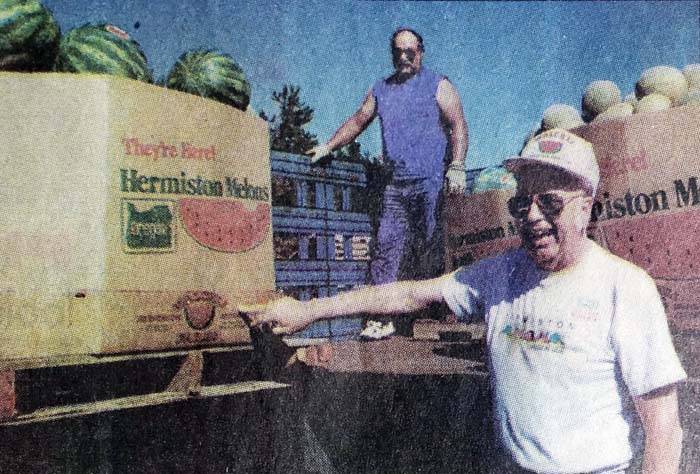Hermiston History: Mayor Harkenrider beats Portland mayor in seed spitting in 1997
Published 6:00 am Monday, August 15, 2022

- Hermiston Mayor Frank Harkenrider, front, and Umatilla Chemical Depot employee John Janis, back, load a truck load of watermelons in August 1997 in preparation for the seventh annual Mayor‘s Tailgate Party at Pioneer Courthouse Square in Portland.
25 YEARS AGO
Aug. 19, 1997
Beating Portland Mayor Vera Katz in a watermelon seed-spitting contest was sweeter than the watermelons themselves for Hermiston Mayor Frank Harkenrider.
The Mayor’s Tailgate party and its seed-spitting contest was started by Harkenrider in 1991 at Pioneer Courthouse Square in Portland. Katz won the 1996 seed-spitting contest, and since watermelons were his city’s claim to fame, Harkenrider was not going to let it happen again. This time, he bested her 9-foot distance with a whopping 17 feet and three inches.
However, both lost to Hermiston Chamber of Commerce President Ray Jones, who launched a seed 25 feet, five inches for first place. Gov. John Kitzhaber, making his seed-spitting contest debut, was right behind Jones with 22 feet and seven inches.
Aside from providing watermelons for spitting, Hermiston growers sent eight tons of watermelon and cantaloupe along with more than one ton of carrots to Portland. Much of the food was then donated to FISH, a Portland-area food program for the needy.
Not only did the event provide some friendly competition and food, but an opportunity for unity.
“We meet lots of people and get to see what is going on in other cities,” Hermiston City Council member Bob Severson said. “I think it does build relationships between the east and the west (of Oregon).”
50 YEARS AGO
Aug. 17, 1972
While Hermiston would be sad to see Soil Conservation Service employee Ed Weber leave, with his new appointment to the Corvallis unit, it was thankful for the grand work he had done.
Weber served as a technician with the SCS of the U.S. Department of Agriculture in the Hermiston District for 16 years. During that time, he assisted with the design, installation and development of numerous projects. That included laying out 65 miles of irrigation and field ditches, 50 miles of irrigation pipeline, 45 drainage systems, 250 sprinkler systems, 350 improved flood systems, 9,000 acres of land leveling and more.
Weber also developed a procedure for grade control on land leveling jobs without the need for surveying instruments, for which he received a national SCS award.
But Weber did not just work on the land of Hermiston. He was an active community member, lending a hand with local Boy Scout groups, vocational education programs, teacher workshops and the creation of the new recreational complex, which was named “Weber Field” in his honor.
75 YEARS AGO
Aug. 21, 1947
In addition to the typical fair attractions, a special air show put on by a fighter squadron would render the 1947 Umatilla County Fair a memorable one.
Col. Frost would lead the squadron, which would stage tactical maneuvers over the Hermiston Air Field, and encouraged Umatilla County residents to attend what would be the climax of the fair. Among other things, he planned to feature an AT-6 on the ground to display how airborne planes could be controlled and informed from the ground by radio.
The air field would be open at 10 a.m. for people to inspect new aircraft and go for short rides. The main show was scheduled to start at 2 p.m., with the fighter squadron performing an hour later.
Sponsored by the Sky Roamers Club, all proceeds from the air show would be put towards improving the Hermiston Air Field.
90 YEARS AGO
Aug. 18, 1932
What becomes of the Indians when Round-Up is over? This was a common wonder of visitors who attended the Pendleton Round-Up.
Most assumed they went back to their teepees, wearing full war regalia and beaded dresses. However, the truth was that their lives are not much different than ours.
When the dust of packing up the Round-Up had settled, one would see Indians sporting outfits similar to their white counterparts. In fact, the elegant and costly garments seen during Round-Up are worn sparingly as they bear great religious and cultural value.
As for the teepees made of elk hide and other skins, they would be dismantled as the Indians returned to their rather modern homes on the Umatilla Reservation. There, their lives run fairly parallel to others of Eastern Oregon as they farm or lease land allotted by the government.
Then when Round-Up came around again the next year, the traditional clothing and teepees would be taken out once more to share a part of their culture with the rest of us.





